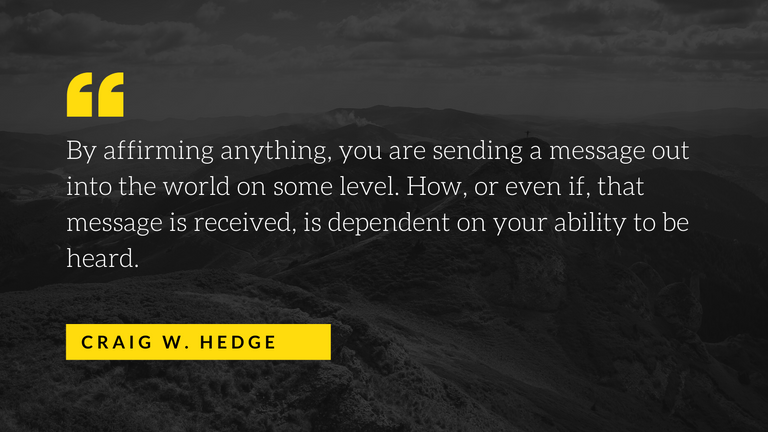
Hey Everyone,
Last week I said I was going to read The Affirmation Matrix and post a summary of each chapter on Monday. Well, the book was an easy read and I felt like it was pointless to draw it out by summarizing one chapter at a time. There are other books I want to read so I summarized the rest in one go. Enjoy.
The Affirmation Matrix
2-Sentence Summary
The Affirmation Matrix guides the creation of powerful affirmations that resonate with your values and beliefs. The book teaches a measured approach to build affirmations and touches on more esoteric philosophies like the Law of Attraction.
Bullet Point Summary
The Affirmation Matrix can be boiled down to these bullet points:
- The cookie-cutter approach to affirmations is ineffective.
- Understand what you want by doing a self-assessment.
- Write your affirmations in bold, clear, everyday language.
- Focus on your strengths and gratitude to utilize the Law of Attraction.
- Use categories, vision boards, and imagination to maximize the results.
Favorite quote from the author

Created in Canva
Introduction
Have you ever tried to use affirmations only to be disappointed by the results? Maybe you read a book on the Law of Attraction and got excited about it. Then when you tried to apply it with affirmations nothing happened!
The problem might be that you were using affirmations from a website. Or you sabotaged your results because you didn’t believe what you were saying.
The truth is any number of things could have gone wrong. Craig W. Hedge is a certified life coach who goes beyond the cookie-cutter affirmations that most people are familiar with. He teaches you a methodical system for creating powerful and effective affirmations.
Lessons from The Affirmation Matrix
Lesson 1: You already use affirmations, so take control by creating them intentionally with the right information. Affirmations are intentional words, sentences, and phrases designed to create circumstances and conditions that one hopes to achieve. You use affirmations unintentionally because everything you think, feel, and do contributes to your life experience.
Affirmations need to be made with the right information. They are more powerful when you create them yourself, instead of using stock affirmations.
Lesson 2: Get personal with your affirmations by creating your own.
Your affirmations should be personal, and deliberate. They should reflect your ideas of power and relevance, not someone else’s.
Use clear, bold language that you understand and is part of your regular vocabulary.
The best time to create affirmations is when you’re aware of who you are. It’s not a good idea to create affirmations when you’re anxious or in a low state of mind.
Lesson 3: A personal inquiry helps you understand your 'why'. Effective affirmations require intimate knowledge of your beliefs, values, and goals. They're not a quick fix, because they require time and effort. The effort comes from going through a process of self-inquiry. It’s not enough to simply say that you want something. You must understand your ‘why.’
The inquiry process tests what it is that you want and helps you find clarity.
If you want something specific, like wealth, ask yourself questions that get to the heart of why you want it.
Ask why you want wealth, what it means to you, and what you would do with it.
The next part of the inquiry is to find areas of your life where you already have the thing you want. There’s more to wealth than money, so find ways that you are already wealthy.
The inquiry process helps you to think more widely, and it helps you see that you might be closer to your goal than you think.
Lesson 4: Leverage techniques that maximize your results. Once you’ve begun building a portfolio of affirmations you can use techniques that amplify their power.
Focus on Gratitude: Gratitude gets overlooked because affirmations usually focus on what you don’t have. Gratitude magnifies the things that are already working for you. When you take stock of what’s already going well, the Law of Attraction brings more of it into your life.
Categorize by risk: This technique creates a wider range of possibilities for you and expands your mind.
Build an affirmation portfolio in the way you would a stock portfolio by organizing them as low-risk, medium-risk, high-risk, and blue-sky risk.
Low-risk affirmations represent tangible goals. They state a process and have concrete outcomes.
In six months, I will have saved ten thousand dollars.
Low-risk affirmations are the kind you can count on in all kinds of conditions.
Medium-risk affirmations are like low-risk ones. However, they may require favorable conditions for them to come true.
My share portfolio will increase by twenty percent this financial year.
High-risk affirmations are effective at stretching your mind. They are good to have in your portfolio because they encourage you to reach beyond your comfort zone. They don’t state a process; something extraordinary would need to happen for them to come true.
I am going to have one hundred thousand dollars in twelve months.
Blue-sky affirmations are bold and defy logic. The real value of them is they make your other affirmations look conservative and achievable.
Understand the Law of Attraction: The LOA suggests that you create, and manifest situations based on what you’re paying attention to. Your energy attracts to you what, and who, you are.
Use visualization: Visualization techniques include vision boards, movies, and meditation. Creative visualization moves you closer to the experiences you want in your life by imagining intimate details about what you want.
Conclusion
This book isn’t revolutionary by any stretch of the imagination. All its information can be found elsewhere. But the Affirmation Matrix is still a handy self-improvement book! The author’s methodical system can certainly make your affirmations more effective. I would recommend the book to anyone who wants another self-improvement tool in their toolbox. If you’re into the Law of Attraction, learning to write effective affirmations is necessary for making it work.

